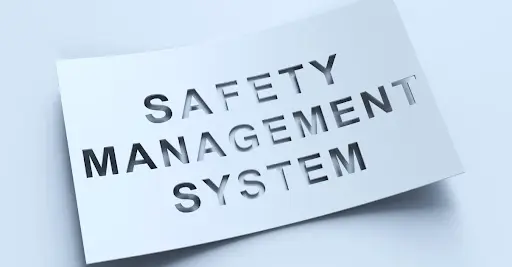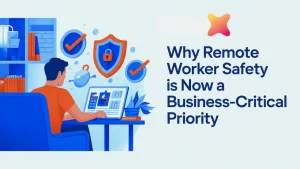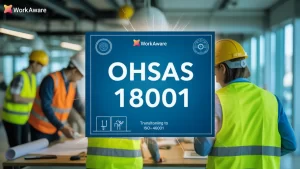What Is a Safety Management System (SMS)? Elements, Examples & Best Practices

A Safety Management System (SMS) is a formal framework that helps organisations systematically identify, manage, and reduce workplace safety risks. It comprises four key components: policy, risk management, assurance, and promotion and drives safety culture and compliance.
A Safety Management System (SMS) offers a definitive approach to managing safety hazards. It allows organizations to find hazards, evaluate risks and respond before things get worse. Because of new rules and the need to look after employees, safety must now be managed in a formal way.
Whether you’re working in aviation, manufacturing, construction, or any other high-stakes industry, implementing a basic safety signs and symbols is crucial for legal compliance and operational efficiency.
What Is a Safety Management System (SMS)?
A Safety Management System (SMS) is a comprehensive framework that integrates organisational structures, accountabilities, policies, and procedures for managing safety risks. The SMS model follows proactive and reactive methods to prevent incidents, enforce compliance, and improve operational performance.
OSHA points out that the best safety and health programs are those that find and solve hazards before anyone is hurt or becomes ill. ISO 45001, the international standard for occupational health and safety, also facilitates the installation of Safety Management Systems (SMS). It explains that SMS helps an organization take steps to improve its occupational health and safety and accomplish its objectives.
So, when you hear someone ask, “What is safety management system?”, think of it as the combination of policies, processes, and practices that work together to reduce risk and ensure safety outcomes.
Purpose: Risk control, safety culture, compliance
Core Components: Policy, Risk Management, Assurance, Promotion
Ideal For: Aviation, Manufacturing, Oil & Gas, Construction
Standards: ISO 45001, ICAO Annex 19
What Are the 4 Core Elements of an SMS?
- Safety Policy – A written commitment to safety from top leadership.
- Risk Management – Identifying, analyzing, and mitigating workplace hazards.
- Safety Assurance – Monitoring and evaluating safety performance regularly.
- Safety Promotion – Training, communication, and a culture that values safety.
Why Does My Organization Need an SMS?
Implementing a Safety Management System:
Reduces workplace accidents and downtime
Improves regulatory compliance
Builds a culture of accountability
Enhances risk awareness and control measures
How Do You Implement a Safety Management System?
Develop a clear and actionable safety policy.
Identify and evaluate workplace hazards.
Assign responsibilities to safety roles.
Conduct training and awareness programs.
Monitor and audit system performance.
Use feedback for continual improvement.
Define Safety Management & Safety Management System
Let’s define safety management first. Safety management involves regularly finding hazards at work and lowering risks by planning, developing policies, and involving employees.
Now, to define a safety management system (SMS), think of it as the framework or platform that enables safety management. While safety management is the general effort, an safety management software makes measuring and maintaining the effort possible.
They are closely connected. The goal is to manage safety, and the system is how we do it. Professionals need to comprehend the distinction when strategizing for the future.
Core Elements of a Basic Safety Management System
A basic safety management system includes four essential pillars. They can be designed for different industries, but their structure is usually the same.
1. Safety Policy and Objectives
A clear and documented safety policy signals the company’s commitment to safety. This means creating goals and giving tasks to people at every level of the organization.
2. Risk Management and Hazard Identification
This means noticing hazards, assessing the dangers they bring, and doing something to eliminate or lessen them. It is insufficient to handle incidents after they happen; organizations should also predict them.
3. Safety Assurance and Audits
Audits, inspections and performance reviews check that the SMS functions correctly. It allows us to find out what needs to be improved.
4. Safety Promotion and Training
Employee training, safety meetings, and regular communication are key to promoting a safety-first mindset. A system’s effectiveness depends on the people who use it.
Industry-Specific SMS Examples
To fully understand how SMS works in practice, here are a few real-world safety management systems examples across different industries:
SMS: Safety Management System
PDCA: Plan-Do-Check-Act
ICAO: International Civil Aviation Organization
ISO 45001: International standard for Occupational Health & Safety Management Systems
1. Aviation Industry
Airlines use the ICAO SMS framework which covers hazard reporting, regular pilot training and live monitoring of aircraft systems. Because of this, there are now fewer incidents caused by human error.
2. Construction
Large construction firms use SMS to handle risks at the construction site. This covers checking that PPE is used, assessing fall risks, and holding toolbox talks. Now, incident reporting software are used to report incidents as they happen and conduct safety inspections.
3. Manufacturing
SMS is used together with Lean and Six Sigma methods by manufacturers. To reduce downtime, the company follows a single system that includes machine maintenance, handling chemicals and team member safety training.
SMS Safety Management: Purpose & Benefits
The purpose of SMS safety management is to shift from reactive to proactive. Instead of waiting for an accident to occur, the goal is to anticipate and prevent it.
Key Benefits:
- Proactive Risk Mitigation: With a formal structure, risks are managed before they lead to incidents.
- Regulatory Compliance: Aligning with standards like OSHA or ISO 45001 helps avoid legal issues and penalties.
- Improved Productivity and Morale: A safe environment fosters trust, engagement, and job satisfaction.
- Continuous Improvement: The SMS evolves with your organization’s needs through audits and feedback.
Implementation Steps for a Basic SMS
If you’re setting up a basic safety management system, here’s how to get started:
Step 1: Get Leadership Commitment
The involvement of top management should begin from the beginning. If they don’t support the system, it won’t succeed.
Step 2: Assess Risks and Identify Hazards
Conduct a thorough risk assessment. Identify hazards in each department and arrange them by how serious they are.
Step 3: Establish Safety Objectives and Policies
Make your goals easy to understand and easy to work towards. For instance, “Cut workplace injuries by 20% within the next year.”
Step 4: Develop Procedures and Controls
Standard Operating Procedures SOPs should be made up of checklists, emergency response plans and communication protocols.
Step 5: Train and Involve Employees
Run training sessions and engage employees in safety committees. Their buy-in is critical.
Step 6: Monitor, Audit, and Review
Keep an eye on statistics such as the number of incidents, close calls and how audits turn out. Use the information to keep improving your business.
Challenges & Solutions in Safety Management
Even the best SMS will face obstacles. Understanding these challenges helps you stay ahead.
Common Issues:
- Resistance to Change: Employees may see new policies as burdensome or unnecessary.
- Poor Communication: If safety goals aren’t clearly communicated, compliance drops.
- Inconsistent Enforcement: Without consistent application, even the best systems fail.
What Tools Support SMS Implementation?
Using modern tools helps centralize safety activities and generate real-time emergency action plan for corrective actions.
How to Overcome These:
- Leadership Modeling: Leaders should set the tone by following all safety protocols.
- Engage Workers Early: Involve them in the design and rollout of the SMS.
- Use Technology: Mobile apps and digital dashboards can simplify tracking and training.
Conclusion
SMS is not limited to just paperwork. The definition of a safety management system includes using it to keep workers safe, comply with laws, and promote a strong safety culture.
If you are in aviation, construction or manufacturing, using an SMS guarantees that safety is always planned. If professionals understand the main parts, advantages and methods of implementation, they can design systems that matter.
Frequently Asked Questions
A Safety Management System (SMS) is a structured approach to managing safety risks in the workplace. It includes policies, procedures, and practices designed to ensure safe operations.
The 4 key elements of an SMS are:
Safety Policy
Safety Risk Management
Safety Assurance
Safety Promotion
SMS reduces workplace incidents, increases compliance, and builds a culture of accountability and continuous improvement.
Implementation varies by industry and organization size. Typical deployment takes between 3 to 9 months with ongoing adjustments.
Document control systems, inspection software, and digital risk dashboards help streamline SMS operations.






